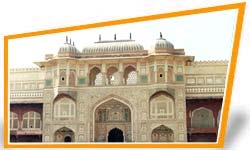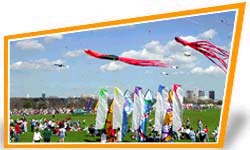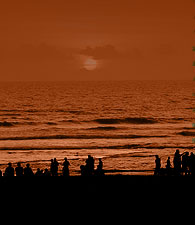Sq. Area : 200.4 sq Km
Population 2,779,881
Avg Rain : 31.87cms
Avg Temp: Summer 36°C to 42.2°C,
Winter 5°C to 24°C
Airport : Sanganer Airport Bus Stand: Jaipur Sindhi Camp
Bus Stand Train Station: Jaipur Railway station
Tel. Area Code : (91) (0141)
Languages:
Rajasthani, Hindi, and English
Best Time to Visit Jaipur : July thru Mar
Jaipur is the capital of the colorful state of Rajasthan and is almost 260 kilometers from New Delhi. It is very
conveniently connected by road, rail and air from the country's capital.
Popularly and aptly known as the Pink City because
of its architectural palaces and monuments in pink, Jaipur is one of the most interesting and beautiful cities of India.

It
was founded in 1727 AD by Sawai Raja Jai Singh and the color pink was used to create an impression of the red sand stone of the Mughal cities.
Begun in 1727 and completed in just 8 years, Jaipur was the first city in India to enjoy rigorous town planning according to the principles laid down in "Shilpa Shastra," an ancient Indian treatise on architecture. The city is protected by high walls, with wide, straight avenues that divide it into nine sectors (apparently reflecting the nine divisions of the universe, resembling the Indian horoscope), each named after the commodity and caste who lived and practiced their specific skills here - the order and space was at the time a total revolution in Indian cities. Although these market names still provide some clue as to what can be found in the otherwise rather uniform rows of shops that line the streets, the overall significance of these historic divisions is today lost to the traveler on foot trying to negotiate the chaos of the filth-strewn streets and pushy traders.
Why Pink? Jaipur is known as the Pink City, a rather idealized description of the terra-cotta-colored lime plaster that coats the old part of the city's walls, buildings, and temples. The reasons for painting the town pink are unknown, but various theories have been tossed about, from using pink to cut down glare, to Jai Singh II's apparent devotion to Lord Shiva (whose favorite color is reputedly terra-cotta). Others believe Singh wanted to imitate the color of the sandstone used in the forts and palaces of his Mughal emperor-friends. The most popular reason (spread no doubt by "Britishers" during the Raj era) is that pink is the traditional color of hospitality, and the city was freshly painted and paved with pink gravel to warmly welcome Edward VII for his visit here in 1876. In 2000 the city was again painted for a state visit, this time by former U.S. president Bill Clinton, and a few streets became off-limits to cars -- thankfully, this is still the case at Bapu Bazaar, which as a consequence is the best place to browse.
Places of Interest ( Attractions ) in Jaipur- City PalaceA magnificent structure, the palace occupies one seventh of the walled city of Jaipur and is a wonderful blend of Rajput and Mughal architecture. The City Palace is now converted into a museum, except a small portion that is still used by the royal family. Built in the fortified campus style, the palace covers almost one-seventh part of the city. Constructions and additions to the palace continued until twentieth century. The palace houses an extensive collection of rare manuscripts, Mughal and Rajasthani miniatures, Mughal carpets, costumes and textiles, arms and weapons, objects of art and royal paraphernalia. One of the major attractions in the museum is the portion that is devoted to the arms and ammunition used by the royal family in the past. Other important attractions are the Textile and Costume Museum, Art Gallery, Chandra Mahal, Mubarak Mahal, and Diwan-i-Khas and Diwan-i-Am.
- Amber FortStanding tall over a small hillock overlooking the Pink City, Amber is the classic romantic Rajasthan fort-palace. Amber today is nothing but a reflection of the glorious past of the fierce Kachwaha Dynasty that ruled over this region from 12th to 18th century.

Man
Singh I started the construction of this fort in 1592 and, perhaps,
it was the defence that topped his priorities before constructing
this fort. The rugged walls of this fort may not look beautiful from
outside, but the interior is a virtual paradise and painted scenes
of hunting and wars adorn the walls along with precious stones and
mirrors set into the plaster. Half the fun at Amber Fort is the walk
from the road to the fort with majestic views of the surrounding
valley. An elephant ride up to the fort is also an unforgettable
experience.
- Jaigarh Fort This fort was
cleverly built to give its archers an advantage over their targets.
It is said that Raja Man Singh buried huge treasures here. The fort
also houses the Jai Ban - the largest cannon in Asia, rumored to
have been test fired only once. Situated in the north of Jaipur, the
Jaigarh Fort is structurally similar to the Amber Fort. Other
attractions in the Jaigarh Fort include three water tanks, a museum,
and breathtaking views of the city below.
- Hawa MahalStrange
though it may seem, this most famous landmark of Jaipur is not
actually a palace but a series of sandstone screens. This pink
structure was constructed so that the ladies of the palace could
watch the royal processions without being seen by any outsider. This
sandstone edifice was named Palace of Winds after the many brass
wind vanes that adorned it until 1960s.
- Jantar
MantarThis largest stone observatory in the world has a
very interesting story behind its construction. Sawai Jai Singh, the
founder of five observatories in India including this one, was a
great admirer of developments in science and technology, especially
astronomy. Before constructing this observatory, he sent his
emissaries to all corners to the world, who returned with many
manuals of cutting-edge technology including a copy of La Hire's
Tables. He built the structures following every detail given in the
manual, but at the end, he found to his astonishment that the
observatory was 20 seconds more accurate than that given by La Hire.
Situated near the gate of the City Palace, the observatory has 18
large instruments, many of them still in working condition.
-
Nahargarh FortNahargarh meaning abode of the tigers was
built by Jai Singh to bolster the defense of Amer. Originally called
Sudarshan Garh, Nahargarh offers a breathtaking view.
-
Albert HallErected in the middle of Ram Niwas Garden,
Albert Hall was built in 1876 to mark the visit of Prince of Wales.
It was designed by Sir Swinton Jacob and opened in 1887 as a public
museum. It contains a fine collection of sculptures, paintings,
decorative art objects, natural history specimens, an Egyptian mummy
and a celebrated Persian Garden Carpet.
- Sisodia Rani
Ka BaghThe terraced Sisodia Rani Ka Bagh (the Garden of
Sisodia Queen) is situated on the Jaipur-Agra road at a distance of
6 km. The garden was created by the queen of Jai Singh II as an
escape from the court intrigues. The landscaped gardens and murals
of the life of Lord Krishna, decorating its interiors, are
breathtakingly beautiful.
Jaipur ShoppingWhen it
comes to shopping in Jaipur, it is a paradise. This is one of the
few places where the shoppers may actually watch the skilled
artisans producing the articles they want to buy.
Fairs & Festivals of Jaipur- Gangaur FestivalGangaur
Festival is usually celebrated in March or April, a fortnight after
Holi. It is the most colorful and important festival of Rajasthan.
The womenfolk worship Goddess Gauri, the consort of Lord Shiva for
marital bliss, long lives of their husbands and conjugal happiness.
During this eighteen-day long festival, the girls and married women
dress up in their traditional ghaghras and cholis. The idols and
images of the Goddess are ornamented in beautiful dresses and exotic
jewellery and women make offerings to her for her blessings with
great devotion. The period is considered auspicious for marriages.
In Jaipur, colorful and huge procession highlighting richly bedecked
horses and elephants, music and palanquins are taken out through out
the city during the festival in which the main deity of the
festival, Gangaur, is taken from the Palace Gate known as Tripolia
across the city, passing through Chaugan, to Talkatora, which
attracts the tourists.
- Elephant FestivalCelebrated
in March, this annual festival of Jaipur is unique in its concept. A
number of beautifully bejeweled and bedecked elephants march
gloriously in a grand procession that savors of royal tastes and
participate in several competitions and events at the time of Holi.
The giant pets run races and play polo at Chaugan in Jaipur, the
venue of the Elephant Festival, with their long trunks during the
festival. There are dancers, musicians and a large number of
onlookers who come there to witness this majestic event. The painted
elephants covered with richly embroidered velvets look grand and
cute at the same time. The procession is accompanies by booming
sound of trumpets and besides the elephants, there are lancers on
horses, chariots, camels, cannons and palanquins lending their own
grandeur to it. There are beauty pageants for the elephants in which
mostly female elephants participate and are groomed industriously by
their 'mahouts' (elephant keepers) for that very purpose.
-
Kite FestivalMakar Sahnkranti celebrated on 14th January
every year is a day of kite flying at Jaipur. People fly kites with
riotous celebration.

Every kite cut loose is an even accompanied by shouts of 'Woh Kata!'
and sky seems nothing more than a big collage of colorful kites in
all shapes and designs. In Jaipur, the Desert Kite Festival is held
in every five years where expert kite makers flaunt their kites,
which are sometimes huge in sizes and often carry social messages or
even caricatures of famous personalities. Open to all, tourists can
also participate in various kite-flying competitions.
-
Teej FestivalCelebrated usually during the first week of
August, Teej festival is marked by rituals and fasts that accompany
the monsoon clouds. The newly washed fields look fresh and beautiful
and peacocks can often be spotted dancing during the season, as
women sing Teej songs and enjoy rope swings in their gardens. Teej
marks the beginning of the series of festivals and fairs that ends
only with the Spring festival of Gangaur. Especially in Jaipur, Teej
is celebrated with a special fervor and showers of rain on this day
pep up the joyous celebrations by several degrees. It is considered
a day for lovers and would-be life partners and young boys and girls
come to the city from nearby villages, singing and dancing on
bullock and camel carts and open tractor-trailers. The procession on
Teej is the highlight of the festival.
How
To Reach Jaipur- By AirAirport
nearest to Jaipur is Sanganer Airport, which is hardly 10 km from
the city. Domestic flights connect Delhi, Kolkata, Mumbai,
Ahmedabad, Jodhpur and Udaipur to Jaipur. However, there is only one
international flight to Dubai
- By TrainJaipur is
well connected by trains to all the major cities of India such as
Delhi, Agra, Mumbai, Chennai, Bikaner, Jodhpur, Udaipur, and
Ahmedabad.
- By RoadA network of good motor able
roads and private and government buses connect Jaipur to all the
nearby major cities such as Delhi and Agra.







